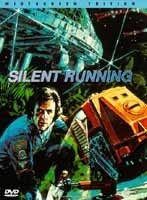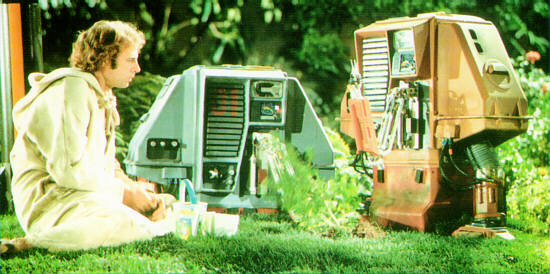| |
1.
Liana Bresler
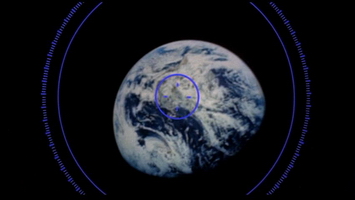 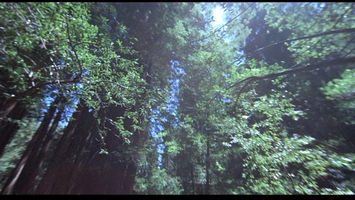
We are
not given many views of the earth in the film, save for the telescopic
view back and Lowell's remembrance of running through the woods. Do
these images match? If nature is gone, how would weather patterns appear?
Although the issue of nature and its disappearance from earth is central
to the plot of Silent Running, there are a few technical gaps
that are never addressed.
The view
of earth from the telescope does match Lowell’s memories
of running through a forest on earth. The image show earth as it exists
today with cloud patterns that suggest the nature and the atmosphere
are functioning normally. That is not, however what we are told the condition
is on earth. If nature is gone, oxygen must be supplied artificially
on earth. This suggests some type of controlled interior environment
that had to be constructed to support life on earth.
Lowell
appears to be in his thirties in the movie, yet he remembers running
through forests as a boy. This means that the extinction of all plant
life on earth and the construction of some kind of life support system
for humans all happened within this short span of time, which is highly
unlikely. Perhaps Lowell’s memory is not meant to be
an actual memory, but what he imagined a forest would be like after seeing
some type of vegetation on earth.
Regardless of the improbable time span, it is hard to imagine how life
can be sustained without any flora (of fauna) on earth, and the movie does
not give the viewers any explanations or clues. |
|
| |
|
|
| |
2. Elfie
Kalfakis
If there
are no plants on the earth, and the temperature is a constant 75F (23C),
what makes the oxygen that people breathe (assuming that in only 8
years people would likely still need to breathe oxygen. Speculate on
the routine act of breathing air.
The movie Silent Running supposes
a state of Earth that has lost all of its forests and vegetation. Of
course if there was not any vegetation left on earth, there obviously
would not be any oxygen left to breathe and the entire ecosystem would
potentially fail. In the movie this issue is not really addressed.
I find it hard to believe that we would have the capacity to synthesize
oxygen to produce breathing air for the earth’s population in
its entirety; this one aspect of the film that is quite flawed.
The actual act of breathing really illustrates the symbiotic relationship
of humans to their environment. Although the film itself brings up many
other environmental issues, the main concern, I believe, is this life
depending relationship that we as humans have with our natural environment.
The actual act of breathing is obviously taken for granted by everyone
because it is a natural process. I find it quite interesting to see how
it is a natural phenomenon that occurs between to elements of the environment
I think that, if the idea of mutual dependability between humans and vegetation
was established as a basis in the film, the catastrophic implications would
have more impact. I think that the film itself sets up a scenario dealing
with major moral issues and the idea of a life depending relationship between
us and forestry was established the film’s point would be a lot influential.
However,
when looking at the act of breathing and it’s illustration
of our relationship to the world around us, the idea of nature seems
to also be something that we as humans take for granted. Of course we
have token tree-huggers who want to save the forest and etc, but the
importance of their preservation seems to really be overlooked by a lot
of activist groups and environmentalist. If we don’t have trees,
we die.
This idea of the fatal implications of losing our natural environment really
opens up at least my eyes to the important sensitivity the built environment
should have to the natural environment. Although we are quite far from losing
all vegetation on the Earth, I can see how sooner or later, perhaps hundreds
or thousands of years down the road these circumstances are plausible. So,
what I take from this film and response is a sincere understanding on the importance
of environmentally conscientious built environment. |
x |
| |
|
|
| |
3. Emily
Maemura
Very little
information is given to us about the state of life on earth at the
time of the film, except in conversation. Describe this environment
in architectural terms. What does it look like? What is it made of?
The
descriptions given of life, and architecture on earth are sparse
and non- specific. Freeman says the temperature is constant, everyone
and everything looks the same, there are no trees, no nature, etc.
He describes and questions these artificial environments, just as he
questions the artificial foods. I can only imagine that he is reacting
to some sort of ultimate fulfilment of modernism of the 60s, of the “International Style” so well known for creating
architecture which looks homogeneous, disregards climate, culture. One can
only guess that the environments on earth seem as artificial as those in
space, merely “machines for living.” Materially, these buildings
would be of metal and concrete, similar to the set which is shown. One can
only infer that there are few windows, and little natural sunlight, since Freeman
himself, a botanist, has forgotten the importance of sunlight to sustain life.
Ironically, the architecture of space has overtaken the earth, and space is
now the only place to artificially sustain the natural environments of forests.
|
|
| |
|
|
| |
4. Derek
McCallum
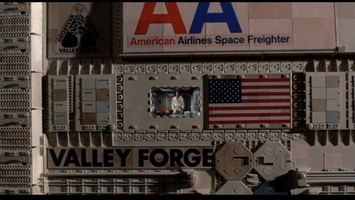 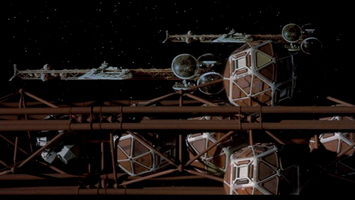
Give your impressions on the effectiveness of the Valley Forge (model)
as it was used in the film. Transitions between the real an the model?
Detail? Believability?
The model
used to create the image of the immense Valley Forge flying through
space has had much thought put into authenticity, detail, and realism – at least as much the budget would allow. I find the image
posted on the website of the ship, with the fake background to provide
depth, much more believable than the pan sequence shown in the film.
The shadows are an effective tool to illustrate a sense of massiveness
and depth of the structure. When viewed from a distance (as in the right-side
image), the level of detailing, paint, and technological aspects (such
as the biospheres) are believable. However, when a closer view is permitted,
the level of detailing is excessive, to the point where it looks as though
the model-builder went overboard in his search for authenticity. It ends
up looking like a giant children’s toy. The biospheres, especially,
look silly with their tiny little panes of glass and the addition of
the forest-saving lights.
The transitions
from the actual set of the Valley Forge to the model also end up looking
rather silly. The cut-and-paste image of Bruce Dern standing in the
window, next to the words “Valley Forge” – which
are of a very similar scale to him – contradict the idea of the
ship as an immeasurable entity, almost devoid of any scale. Again, the
closer look also shows the excessive toy-like detailing, and the plasticity
of the model becomes more apparent. However, I find the lighting at this
scale to still be quite effective in illustrating the surface of the
model as being in space – it is dark, but enough life is given
from the distant sun to bathe the Valley Forge in shadow. |
|
| |
|
|
| |
5. Helen
Pallot
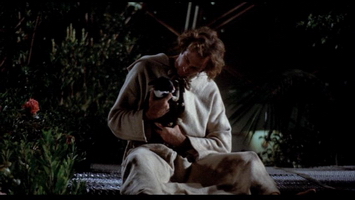 
Imagining that I am not the only one to assume this... How can Lowell
be the last human to place value on something beyond human existence?
Are there more parallels here than those on the surface?
Dressed
in long draping robes reflecting the solitude and simplicity of a medieval
monk, Freeman Lowell represents the good of mankind, which chooses
to look after the treasures of the world. Like a creator he nurtures
and cares for his own Garden of Eden, and when it is threatened he will
do anything to protect it, even kill. It is a pity that the monk on a
mission, who has had eight years of planting trees, takes so long to
realise that plants need sun. Maybe this is a reflection on the undeveloped
plot, but it also shows that besides from the underlying message that
we need to look after our world while we still can, the connotations
of certain parallels of the movie is most likely a result of Bruce Dern’s
overacting. |
|
| |
|
|
| |
6. Allison
Janes
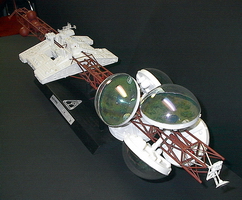 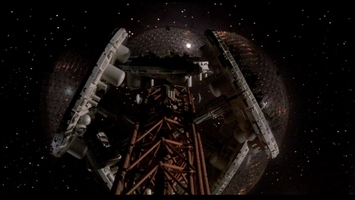
The various domes are placed at angles to the main transportation
shaft in the spacecraft. Does this seem to have any impact on interior
navigation in the film? or on the portrayal of gravity forces, or
lack thereof, throughout the movie. Contrast this with 2001.
The geodesic
domes of the “Valley Forge” are placed at angles
to the main body of the spacecraft, in an attempt to illustrate the occupation
of 360 degree planes in Space. However this doesn’t seem to affect
the interior design or navigation of the spacecraft. The interior corridors
depict a linear movement from one end of the spacecraft to the other,
occupied on a single plane and following the same patterns of gravity
as earth.
The film
neglects to describe how these corridors connect to the angled domes.
In fact the entrances to the domes seem too large for the scale of
the corridors of the ship and they do not illustrate any change of
orientation, movement or gravity. All domes seem to have to same relationship
to the interior corridor of the spacecraft and a similar “ground” plane,
despite their exterior appearance. While there is a depiction of zero
gravity in the design of the exterior of the “Valley Forge”,
it is in essence ignored in the interiors.
In comparison, both the interior and exterior environments of 2001
Space Odyssey address environments of zero gravity. We are shown interior
spaces that are inhabited on all surfaces and shown the methods of navigation
between them. For instance, the movement of a stewardess through multiple
planes of inhabitation is shown in great detail. In the same manner of
detail we understand the apparent presence of gravity on the Saturn outpost
due to the centripetal force applied by the rotation of the spacecraft. |
|
| |
|
|
| |
7. Nathan
Rehorick
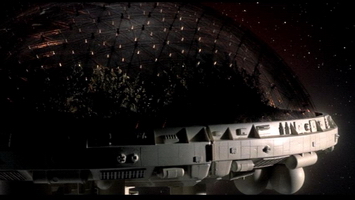 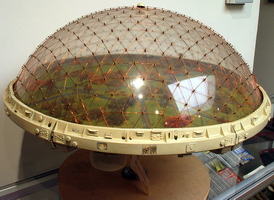
Comment on the construction and use of the dome model in the film. Compare
the use of the model in this film with the models in 2001.
The construction of the domes in Silent Running involves a circular,
thick, metal base plate to which is attached a geodesic space-frame dome
of glass and metal. This dome is attached as an object to the Valley
Forge by a single, massive pier.
The fragility of the thin layer of glass that separates the plants
inside the dome from the vacuum of space outside creates tension between
the existence of the last remaining organic non-human life from earth
and the destruction of this life. The fact that these domes can be jettisoned
into space brings this idea further into light. Indeed, when the first
domes are detached and exploded, this fragility is strongly recognized
by the protagonist, Freeman Lowell.
The domes
are clearly filmed as objects floating in space, as things to be dispensed
with or moved around at will. In addition, the fact that these domes
are not as detailed or as visually convincing as those in “2001” -
while partly due to budgetary constraints - seems to subtly support the
objectivity of the domes. In other words, the role of the dome models
in Silent Running is to simply provide a physical form to the plant life
that is at the core of the principle characters’ dialogues, whereas
the role of models in 2001 have clearer intimate roles with the physical
actions of the characters. For example, the fight scene that takes place
in the final dome on the Valley Forge is filmed from close-up, with little
emphasis on the environment, whereas at the excavation site on the Moon
in 2001, the descent and movement of characters is filmed slowly and
deliberately, often over someone’s shoulder to the surrounding
context.
Interestingly, it is only during scenes inside the domes that they become
actively inhabited environments. Plants and animals create a romanticized
natural interior world. Lowell talks nostalgically about the lost value
of organic life, while gazing through framed glass back towards earth.
In this sense, the domes have a dual role.
Both the construction of the domes and their romantic inhabitation -
both eloquently set against the harshest of environments - space - are
employed to illustrate the objective attitudes that humans often take
towards their natural environments. This idea makes sense particularly
when viewed in light of post-modern and reactionary environmental movements
that were shaping culture at large at the time of the film, the early
1970s. |
|
| |
|
|
| |
8. Matt
Storus
 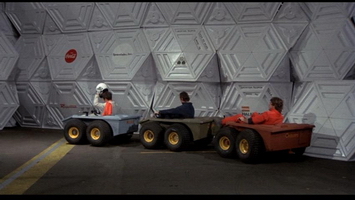
There is a lot of unusual geometry used in the sets and objects of
the film. This seems to become a trademark of "space" films.
Why? Is it effective? If these shapes are so good for the future, why
do we not find them in present time?
The unusual
geometry used in Silent Running is deployed as a way to represent advanced
technology. For example, the shipping crates in the Valley Forge are
constructed as hexagonal shells. By taking something as mundane as a
shipping container (something the audience would identify with a simple
rectangular box) and making it foreign and vaguely complicated, it reinforces
the illusion of a future time. Similarly, the interior and exterior geometry
of the ship reflects a curiosity with facetted geometry. This technique
is effective, as used in combination with other strategies such as a
technological “veneer” of
pipes and boxes along most surfaces.
These shapes
are not typically present in most constructions today simply because
they would be too expensive and impractical. While a hexagonal shipping
container may look efficient, it has many more faces and joints than
a simple rectangular box. Similarly, a square hallway is much less complex
and expensive to construct than an angular one. However, when looking
at the structure of the Valley Forge, there are several components that
bear close resemblance to existing structural types. For example, the
spine of the ship is one giant space-frame truss. The domes over the
forests are reminiscent of Buckminster Fuller’s geodesic domes.
In fact, that type of structure would have been deployed by the filmmaker
as a reference to those particular structures that would have been familiar
to most of the audience, and associated with futuristic construction.
The choice of facetted geometry, however, also uncovers an underlying
proposition about progress as envisioned in the 1970s, particularly with
reference to the overall theme of the film. Facetted geometry was not the
only way to show advanced technology. For example, the ship might have
been constructed with curvilinear or organic geometry, which would have
been equally complex in appearance. However, the choice of a deliberately
artificial geometry highlights the absolute artificiality of their spaceship,
and a fundamental disconnect with nature. It is portrayed as a poor habitat
as compared to the natural habitats they might have remembered on earth. |
|
| |
|
|
| |
9. David
Takacs
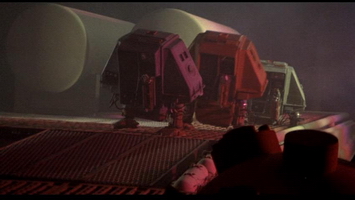 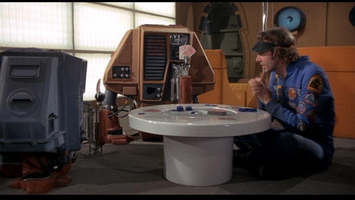
Huey, Dewey
and Louey gave birth to R2D2. Their assignment of lovable personalities
in this film gave rise to a real change in the role of the robot in science
fiction films. How do you perceive that this changed this film genre?
Speculate on their absence from this film.
In the science fiction film Silent Running,
Freeman Lowell, the main character, is stranded in outer space on the
Valley Forge, taking care of the earth’s last forests. Here we
see a new character archetype emerge in film, the lovable robot. Since
then numerous films of all genres have made the robot quite common,
but there is no doubt that Silent
Running was one of the first.
This changed the genre in numerous ways. With Huey, Duey, and Louey,
the robots in the film, people gradually start to accept the ideas of
humans interacting in a passionate way with robots. In previous films
such as 2001: A Space Odyssey, the robot is stereotyped as a
threat, the inevitable end of the relationship between robots and humans. Silent
Running dispels this, and highlights the need for social interaction,
regardless of whether it is human or not. The movie itself feels B-list,
but it tackles an interesting problem where the hero has forced himself
into isolation for the greater good of mankind, and thus has to adapt
to his new situation. This not only changes the genre by making robots
acceptable, if not rather commonplace, but also makes the future they
portray more credible. It is scarcely possible to imagine the future
without the presence of innumerable robots. I can imagine myself interacting
with robots in all sorts of ways, but without films like this would hardly
be the case. This expounds on ability of film to facilitate cultural
revolutions. Star Wars ultimately cemented all of this in history,
and it is difficult to speculate on the role of Silent Running,
as I am sure without it Lucas still would have had robots with human-qualities,
but perhaps less articulated.
In speculating
the film without Huey, Duey, and Louey, a number of possibilities can
be drawn. One can pinpoint the exact moment where the robots cease
to be numbers and start to be ‘people,’ when
Lowell assigns them their names. Numerous emotional experiences also
take place, such as when he tries to have them plant a tree, or when
he loads the program into them to play cards, and they beat him; with
him ultimately having a sad goodbye when he leaves Huey to take care
of the garden. Without these momentous events, it could be imagined that
they would have been replaced with a feeble-like character in a way,
such as a young child, or a sub human, like a monkey. It is either their
replacement with something similar, or his having to occupy himself in
solitude, which in his environment would be rather difficult. Ultimately,
both these options seem considerably less exciting. With our modern conception,
it is near impossible to think of this film without the robots, at least
in an interesting way.
Silent Running can be said to have had considerable implications
on the science fiction genre. Whether or not the advent of robots with
loveable personalities was exclusively due to this film is now irrelevant.
It is certainly impossible to imagine it without them. |
|
| |
|
|
| |
10. Mat
Triebner
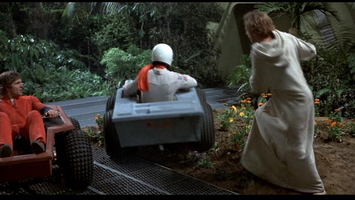 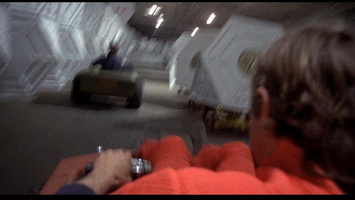
Sport and exercise took on a very different role in this film compared
to 2001. Does this type of activity seem believable or purposeful
for space inhabitation? Comment.
The sport and exercise which occurs during the films, namely that of
the ATV races found in Silent Running, may seem somewhat unbelievable
at first glance, yet it takes on an air of realism when we consider that
the Valley Forge is large enough to carry six enormous ecosystems, and
therefore why not an improvised racetrack? The purposefulness of such
exercises, on the other hand, seems entirely questionable when making
a comparison to the recreation types aboard the Jupiter mission in 2001:
A Space Odyssey.
While we can empathize with the boredom experienced by the astronauts
in Silent Running, and therefore respect their wishes to engage
in some sort of sport, the idea of an improvised NASCAR aboard the ship
seems somewhat excessive. Additionally, the racing aspect of their sporting
life is actually dangerous, as Dewey would eventually learn. Who approved
a racing budget for the mission, anyway?
2001:
A Space Odyssey’s recreational equivalent is then
the hamster wheel-type jogging track which we see towards the beginning
of the Jupiter mission. Although far less interesting than the racing
sequence of Silent Running, it seems wholly more realistic,
serving a vital function of condition the astronauts during their time
enduring pseudo gravity. This was apparently not an issue aboard the
Valley Forge, as gravity played no real role of significance. This perhaps
indicates a far more advanced society, where the ravages of space travel
which take such a great toll on today’s astronauts are no longer
a hindrance to extensive cosmic journeys. 2001: A Space Odyssey cast
members, on the other hand, are still prone to the muscular atrophy space
travel promotes.
But where the two films contrast so evidently in sport and exercise,
their relationships with other sorts of recreation (namely poker versus
chess) are quite similar. Both games, although accomplishing nothing
of value for the mission itself do however, help to keep the minds of
the astronauts not only busy, but quick as well, helping to ease the
massive excesses of boredom likely to overcome them during the course
of their respective missions.
|
|
| |
|
|
| |
11. Andrea
Wong
 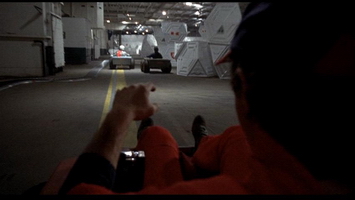
The
set was largely created within an abandoned aircraft carrier. How
has this impacted the resulting film set? For better or worse? With respect
to plot/action? Materiality? Details?
Based on the information shared on the extra-features of the DVD, creating
a set on an abandoned aircraft carrier posed many problems. Firstly,
there was no electricity or running water readily available onboard.
Secondly, all the props, furniture and equipment had to be brought in.
Nothing could be taken for granted because everything had to be provided
and planned for by the film crew. Cinematographically, the aircraft carrier
was made up of mainly dark and confined spaces where it was difficult
to achieve good quality light-levels.
Some of the positive aspects of filming in these conditions were the
resulting homogenous aesthetics, the emphasis on detail and overall feeling
of claustrophobia, which complimented the plot. Because all the sets
were constructed within the same context and parameters of the aircraft
carrier, all of them preserved a similar look and feel, which added to
their credibility. Having all the framework already available and ready
to be modified or dressed enabled the crew to put more attention on the
smaller and more detailed aspects of the sets, like the props. Finally,
the viewer can feel the claustrophobic nature of the movie because of
the set conditions. The characters are trapped on this vessel just like
the actors are on this aircraft carrier.
All in all, despite the logistical problems relating to filming on
the aircraft carrier, the resulting aesthetic and feeling achieved in
this movie is unique and memorable.
|
|
| |
|
|
| |
12. BJ
Smith
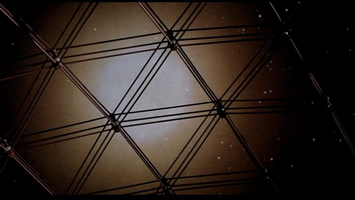 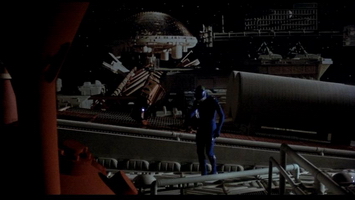
Compare
the presentation of the "climate of space" in Silent Running to
2001. Refer to the use of "barrier systems" for both the
space craft and human clothing that are used to separate interior/personal
environments from the harshness of space. Silent Running was produced
after 2001 with the knowledge of the same f/x person. Which are more
realistic? Why?
Although
hard to know for sure all the hardships and dangers of space, the ability
for science fiction to address the ‘climate of space’ lies
in their ability to create believable sets and props. What Stanley Kubrick
created in his movie, Space Odyssey 2001, was for that time and even to
this day, a successful space fantasy with convincing spacecraft, environments,
space equipment and a believable integration of man and space. The depiction
of the spacecraft’s ‘barrier system’ in Silent Running
is mainly on par with what was shown in Space Odyssey 2001, showing similar
materials, constructions and style, but with the exception of the incorporation
of the garden domes. Within the context of science fiction it is quite
plausible to accept large structures, such as spacecraft, space stations
or in this case a large glass dome, which can be sufficient even though
they appear to be constructed of a fragile material. But it can become
harder to swallow when it must also be there to fend off the harshness
of space - the heat lost through it would be enormous – especially
since space is freezing. This deviation from the overall style and construction
of Space Odyssey’s reality begins to lack the appearance of space
technical knowledge; no longer addressing the ‘climate of space’ and
in turn losing a sense of realism to this preface.
Similarly,
when examining the spacesuits used in both movies we find that there
is a distinct reading with each film. 2001 uses a bulky and more substantial
suit, somewhat reminiscent of what one would expect to see on a NASA
space mission. These costumes are successful at creating the appearance
of a suit, suited for dealing with the harshness of space. In Silent
Running, when we see Lowell outside the ship, the spacesuit he has appears
to be made out of neoprene, and resembles a scuba diving suit - looking
more like pajama’s than a spacesuit. Because of this it
fails to successfully create a perception of defense, leaving this interpretation
of a spacesuit lacking the realistic notion and falling short of addressing
the harshness of space. Overall the filming of Silent Running takes a few
too many ‘short cuts’ in developing the concept and props for
truly convincing the audience compared to the success of Space Odyssey
2001.
Even though
the same f/x person was used in both movies there is a clear distinction
between the two movies’ take on the ‘climate of
space’. That which was presented in Space Odyssey 2001 appeared more
convincing as its technical knowledge seemed to be more thought out. Silent
Running on the other hand had some cheaper looking props and ‘short
cut’ style filming which weaken its realistic feel. Both of which
are present in the above discussion regarding the spacecraft and spacesuits.
Although this may be contributed to the insight and vision of the writer/director,
ultimately this difference stems from the budgeting of the two films. You
just can’t produce the same quality with 1/10 th the money. |
|
| |
|
|
| |
13. Maia
Spadafora
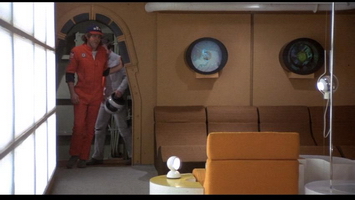 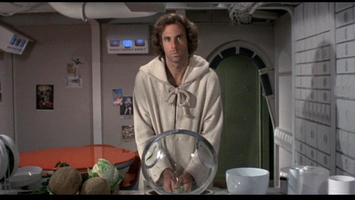
Discuss
the sets/settings used in the "non aircraft carrier" interior
scenes; the operating room, the recreation room, the kitchen.
The setting
used in the “ non aircraft carrier “ interior
scenes is essential, bare, emotionally dull, silent! The set goes almost
unnoticed. The colors choosen for every scene are very similar to one
another : yellow shade for the recreating room, grey tone for the kitchen,
but in any case every color remains “empy and inexpressive” as
in a shallow focus.
The objects
in the rooms and setting are intentionally “not comunicating
and not interesting” so that the focus is on the actors.
The interiors
are more in the 60 th than the 70 th style. There isn’t
any “exploration of the future” in a technological sense,
any allusion to an idea of space, of the unknown or mistery; only the present exists
and it is normal, banal, rendered more human and down-to-earth by photos
with baseball players and childrens hanging on the wall. The only gadget
therefore are objects used in common life.
The only
more articulated room is the cockpit, where the focus is more on the
set, due to the presence of the monitors and machineries which produce
patches of different colors and drive the attention towards what exists
behind the actors. Metal tubes, beams, electric threads articulate
the background, with effects of shade and light that give different
deep layers in the space and yet don’t produce any interest.
Perhpas
the atmosphere appears to change a little when the main actor remains
alone. Objects and plants increase in number. Plants become not only
design objects, a decorum, but also the expression of main actor’s
personality, his sensitivity, his weaknesses. This finally allows to
add something “personal“ to the “impersonal” scenes.
The ambience gradually becomes more and more untidy, the confusion grows
up: foods, glasses, books make the set livelier, speed up the rythm
of the film, but yet fail to be really exciting). |
|
| |
|
|
| x |
14. Davide
Plantera
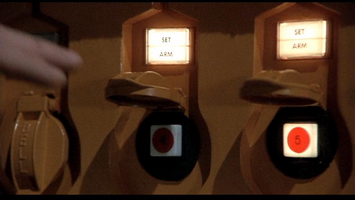 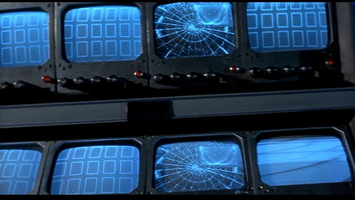
Comment on the presentation of technical gadgetry in the film. Was
it realistic? Did it help the plot? Did it seem in keeping with
the proposed timeline of the film?
In this film gadgets play a very important role and they appear in
all the entire lenght of the film. Gadgets are not only instruments to
control the starship, they are also electronic devices that can provide
facilities and amusements to the occupants of the starship. These devices
infact can cook syntetic food, they can play pool and help the everyday
life of the workers.
It’s not easy to say if they are realistic with the timeline
of the film because some functions of the gadgets are very advanced and
interesting in the concept but the way they look like is often out of
date and obsolet. This is a common problem in Sixties and Seventies Sci-Fi
films because during the 80’s the informatic and electronic revolution
changed definitly the design of electronic devices. Nonetheless they
appear realistic for the imagination of ‘70s and in this period
are very popular also in other Sci-Fiction movies: the food synthesizer
for example is also a Star Trek’s gadget.
The director
Douglas Tumbull is the Kubrick’s 2001 special effects
supervisor, and also in Silent Running he focus his attention in making
good models for his gadgets, expecially the drones. The budget definitly
has influence the way these gadgets look like. The buttons and the controllers
of the computers of the starship for example are too analogic, the bombs
requires a labourious work of hand to set them operative. Generally there’s
too much plastic and wood in these gadgets.
Some of
them, expecially the drones, have a very important role in the second
part of the film. When the main character, Freeman Lowell, remains
alone in the starship the gadgets are important in two way: first of
all they are funny and this allow the public to don’t be bored
by a defintly too slow and contemplative plot (also Kubrick’s Space
Oddity rhythm is slow as well, but Trumbull is not a genius as Kubrick).
Then, they are important because they are the only ones interlocuctors,
an interface bewteeen Freeman and us. When Freeman talk to them we are
helped in understanding the plot. They are more human and their humanity
make us forget about the fact that Freeman has killed three people, his
co-workers that would not follow him in his ideological adventure because
they probably preferred to come back to the Earth to their families (anyone
has noticed the pictures of children hung in the wall behind their shoulders
when the 4 colleagues are having dinner together?).
This is
not only a Sci-Fi film, it’s more a space-comedy with
a strong “green” message. No more Strauss music like in Kubrick’s
2001, but “just” the singer Joan Baez, an idol for the hippies
community and pacifist movement. We can listen to her ballad “Rejoice
in the sun” in several moments of the film and naturally at the
end, when the frames show us a gadget, the drone robot #1, preserving
the plants and the trees, in the dome abandoned in the space in its silent
running.
ps.The
Italian title for Silent Running is “2002,The Second
odissey”,
no comment!!! |
|
| |
|
|
